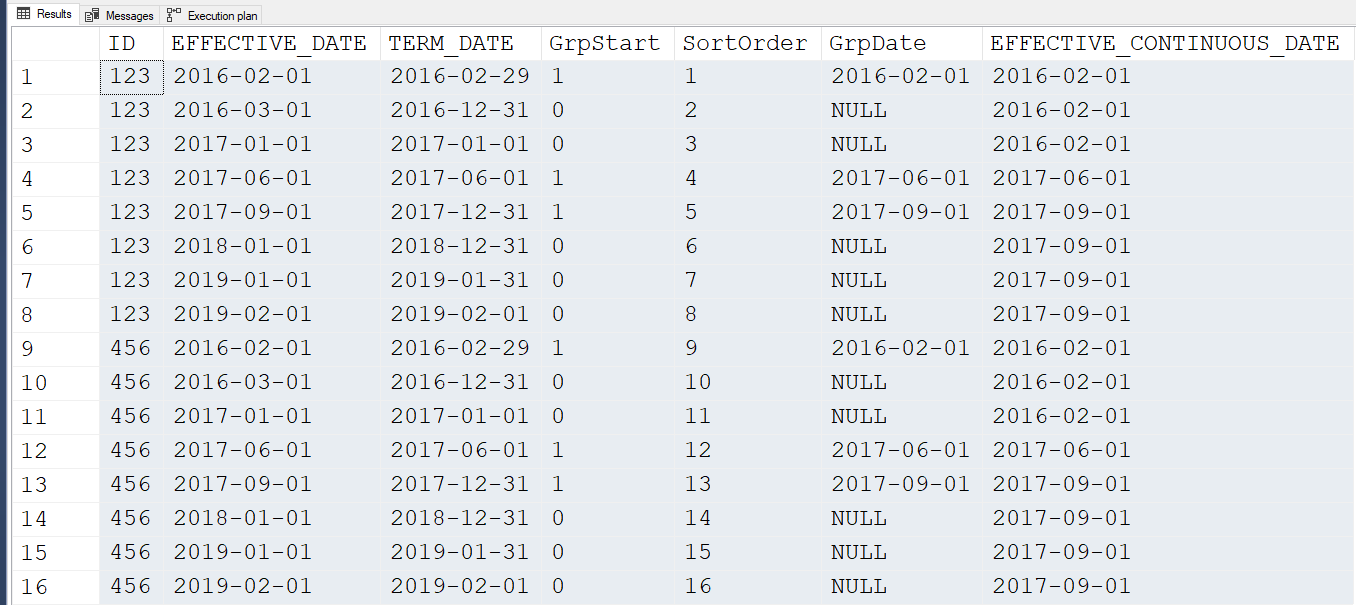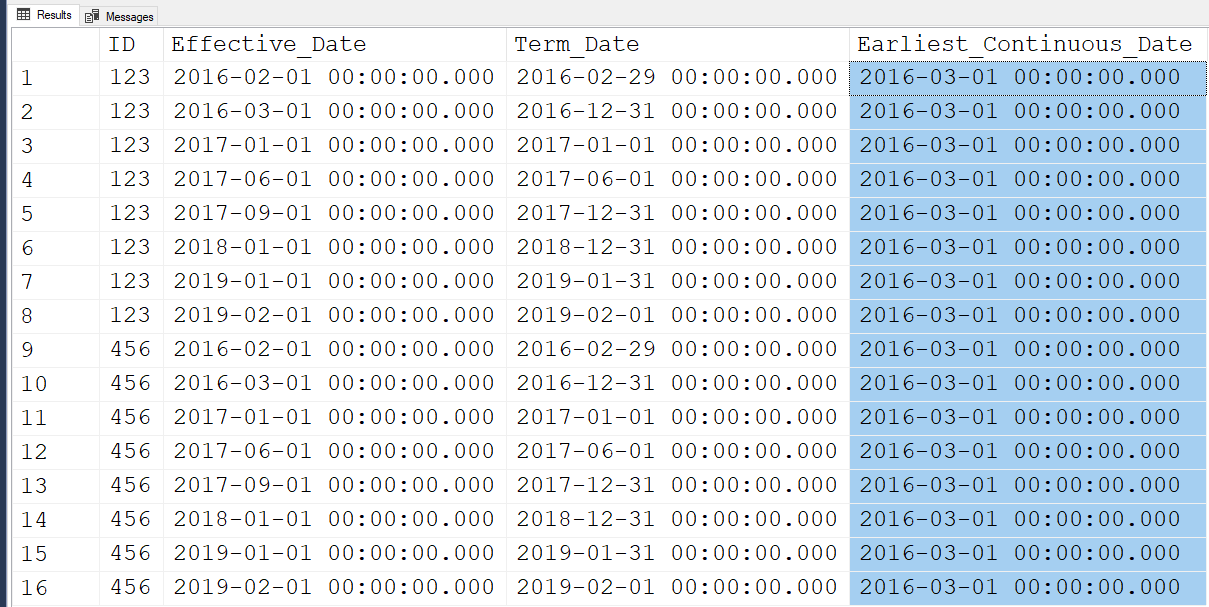Thanks for posting some aligned text instead of a useless graphic. It would be helpful if you took the time to take it the next level and provide the table and some readily consumable data on future posts. Here's how that could look...
--===== If the test table already exists,
-- drop it to make code reruns in SSMS easier.
DROP TABLE IF EXISTS #TestTable
;
--===== Show the data in a "Readily Consumable" bit of code
-- and store it in a temp table to play with.
SELECT v.ID
,EFFECTIVE_DATE = CONVERT(DATE,v.EFFECTIVE_DATE)
,TERM_DATE = CONVERT(DATE,v.TERM_DATE)
INTO #TestTable
FROM (VALUES
(123,'02/01/2016','02/29/2016') --'02/01/2016'
,(123,'03/01/2016','12/31/2016') --'02/01/2016'
,(123,'01/01/2017','01/01/2017') --'02/01/2016'
,(123,'06/01/2017','06/01/2017') --'06/01/2017'
,(123,'09/01/2017','12/31/2017') --'09/01/2017'
,(123,'01/01/2018','12/31/2018') --'09/01/2017'
,(123,'01/01/2019','01/31/2019') --'09/01/2017'
,(123,'02/01/2019','02/01/2019') --'09/01/2017'
-- Added this second ID to prove the survival of the code when it happens
,(456,'02/01/2016','02/29/2016') --'02/01/2016'
,(456,'03/01/2016','12/31/2016') --'02/01/2016'
,(456,'01/01/2017','01/01/2017') --'02/01/2016'
,(456,'06/01/2017','06/01/2017') --'06/01/2017'
,(456,'09/01/2017','12/31/2017') --'09/01/2017'
,(456,'01/01/2018','12/31/2018') --'09/01/2017'
,(456,'01/01/2019','01/31/2019') --'09/01/2017'
,(456,'02/01/2019','02/01/2019') --'09/01/2017'
)v(ID,EFFECTIVE_DATE,TERM_DATE)
;
--===== Show the data in the test table
SELECT * FROM #TestTable ORDER BY ID,EFFECTIVE_DATE
;
GO
Here's one fairly easy (once you understand the concatenation for the MAX) way to accomplish the task using a trick of converting two columns to Binaries to easily find a MAX/OVER and then pluck the date back out from that using a CONVERTed SUBSTRING. Details are in the comments in the code.
--===== This wonderful bit of PFM isn't my original idea. I got it from the post by Drew Allen
-- at the following URL and he got the idea from Itzik Ben-Gan.
-- https://www.sqlservercentral.com/forums/topic/query-help-299#post-4072505
WITH
cteMarkStart AS
(--==== Find the starting row of each group based on being more than 1 day since the previous rows
-- The group starting rows are marked with a "1" and the rest are marked with a "0".
SELECT *
,GrpStart = SIGN(DATEDIFF(dd,LAG(TERM_DATE,1,DATEADD(dd,-2,EFFECTIVE_DATE))
OVER (PARTITION BY ID ORDER BY ID,EFFECTIVE_DATE),EFFECTIVE_DATE)-1)
FROM #TestTable
)
,cteGrpDate AS
(--==== Add a sort by ID and EFFECTIVE_DATE to keep things simple and convert the GrpStart markers to EFFECTIVE_DATE.
SELECT *
,SortOrder = ROW_NUMBER() OVER (ORDER BY ID,EFFECTIVE_DATE)
,GrpDate = IIF(GrpStart = 1,EFFECTIVE_DATE,NULL)
FROM cteMarkStart
)--==== This concatenates the BINARYs of the SortOrder and the GrpDate so we can easily determine the previous or
-- current MAX of the two columns, then SUBSTRINGS the date BINARY back out and converts it back to a date.
SELECT gd.*
,EFFECTIVE_CONTINUOUS_DATE = CAST(SUBSTRING(MAX(CAST(gd.SortOrder AS BINARY(5)) + CAST(gd.GrpDate AS BINARY(3)))
OVER(ORDER BY gd.SortOrder ROWS UNBOUNDED PRECEDING), 6, 3) AS DATE)
FROM cteGrpDate gd
GO
And, here are the results. I left the extra "working" columns in the output so you could see what was going on. You can, of course, change the "*" in the final output to just the columns you want to see in the output.
p.s. I call this type of thing a "Data Smear" because you're "smearing" existing data down to fill NULLs until it hits another piece of NON-NULL data. Some people call this the "Last Previous Non-Null Value" problem.
It IS possible to combine the first two CTEs to eliminate the need for the GrpStart column but the code is already "different enough" to blow the top's off of people's heads and so I keep them separate so it's a wee bit more obvious and the comments explain it better. I don't really do that for other people... I do it for myself, so that when I read it six months from now, I can remember what the hell it was that I did. 



